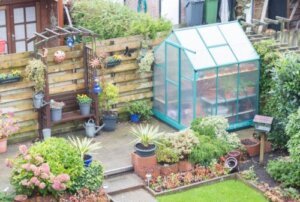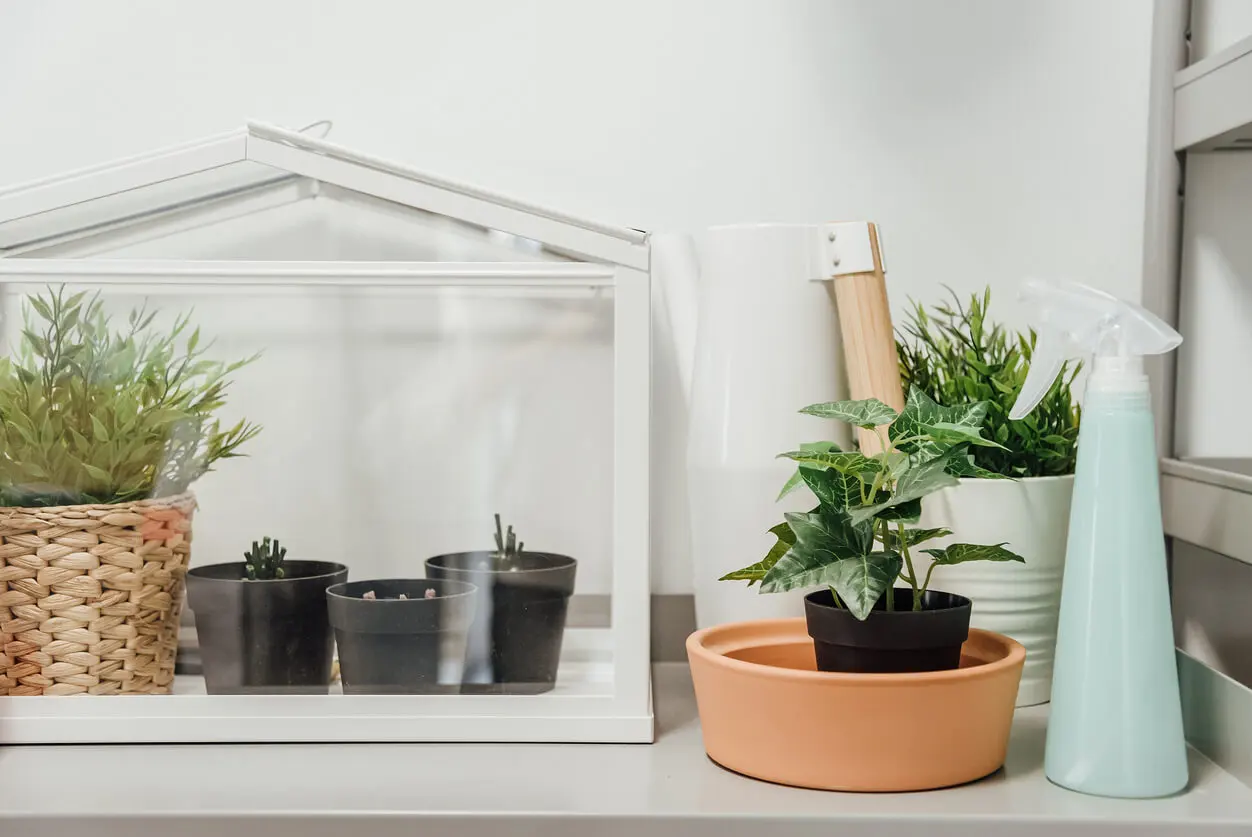Urns and Mini Greenhouses: How to Set One Up at Home

Self-cultivation is a practice used by millions of people, even in large cities. More and more people are choosing to grow their own vegetables, which has numerous advantages from an environmental and nutritional point of view. However, it’s possible to go a step further by installing urns and mini greenhouses.
These are structures that can be adapted to a given space in the home, with which it’s possible to increase the variety and quantity of crops. Placing a mini greenhouse at home has a series of advantages that make it a production and feeding trend. Moreover, it isn’t a complex task.
What are urns and mini greenhouses and what are they for?
Home or small-scale agriculture is becoming increasingly popular. Home gardening and urban gardens have become a widespread phenomenon for those who have their own garden.
But they also exist in homes that only have a small space on the balcony or terrace. To accelerate and improve the cultivation process, it’s best to assemble a set of urns and mini greenhouses.
These are spaces adapted to the ideal growing conditions for vegetables.
Having your own vegetables is beneficial. For this reason, many people choose to set up mini greenhouses with different styles, materials and sizes.
These structures are characterized by transforming a small space into a place with optimal conditions for cultivation. Inside a mini greenhouse it’s possible to generate a microclimate by controlling sunlight, humidity, air and ventilation. Vegetables and fruits grow better as a result.
Steps to set up mini greenhouses
Setting up a mini greenhouse is an excellent way to take advantage of the space in the home and devote it to plants and vegetation. In addition, it makes it possible to grow your own food, with economic, ecological and nutritional advantages.
Urban gardens are ecological, economical and easy to implement solutions for city populations.1. Choose the right space
It’s important to look for a part of the home with enough space to assemble the structure comfortably. This is simpler in houses with small balconies and terraces.
It’s essential for it to be in an area that receives sunlight, so that the light and heat levels of the crops can be regulated.
2. Select the materials
For this step it’s important to take into account the size of the urns and mini greenhouses to be installed. Based on this information, the plastic materials that will form the structure are chosen.
The dimensions must include an extra space to work standing up. In other words, the dimensions should be a little wider than necessary.
3. Prepare the ground for urns and mini greenhouses
If you have a garden, the installation of urns and mini greenhouses is easier, due to the possibility of using soil, easy-to-access places and enough sunlight. To assemble it, you must level the ground, level the soil, and clean the area as best as possible.
Then, delimit the area to be occupied by the structure, marking the angles and corners. Finally, install the anchor and pipes of the mini-greenhouse.
4. Assemble the roof
Once the base structure is firm, you’ll need to place thick plastic over it. This is a special material for this type of construction, which is more resistant and is prepared to receive the sun’s rays and withstand other environmental conditions.
5. Accesses
Once the base and the structure of the mini greenhouse have been installed, the last step is to generate the access sectors. These can be with closures, a roll-up system, or even with sliding doors, but it’s important that they seal well. In this way, the climatic environment of the interior is controlled.
Greenhouse urns as an alternative option
In addition to the cultivation of vegetables in mini greenhouses, there’s another option adapted to the smallest plants of the home. Urns are smaller containers that create a microclimate for the vegetation.
With greenhouse urns it’s possible to keep the vegetation away from contact with smoke, perfumes, and other types of substances that can be harmful. Urns are perfect for complex specimens that require special growing conditions.
Discover more here: The Nutritional Value of Red Fruit and Vegetables
Features of greenhouse urns
Greenhouse urns can be made of different materials, but they must be transparent to allow light to enter. In general, they usually have glass walls. Their installation is simple and they have a variety of designs and styles, in order to adapt to the house decoration.
Before inserting the plant, the area must be well sanitized. In addition, a tray must be placed as a base, in case it doesn’t have one. Then, form a floor with clay and a little water.
The glass should be kept clean and transparent so that the plants receive the necessary light, although it isn’t recommended that the sun’s rays hit it directly. Finally, it’s a good idea to open the lid from time to time, in order to ventilate the urn and moisten the substrate with a sprayer.

Advantages of growing vegetables at home with urns and mini greenhouses
Growing edible vegetables isn’t only an aesthetic or environmental issue. Growing vegetables has economic and nutritional benefits.
It’s possible to obtain 100% organic products, harvested from personal monitoring. Although it isn’t a complex task, it’s advisable to start with simple products, and then move on to mini greenhouses.
All vegetables grown at home have a number of advantages from the point of view of sustainability. This is because transportation costs and emissions are reduced, while seasonal vegetables are prioritized.
Other advantages are as follows:
- Ecological: with our own crops we’re sure to produce vegetables in an ecological way. That is, without chemicals that harm the environment.
- Less waste: growing your own vegetables encourages you to incorporate more vegetables into your daily diet, while less food is wasted.
- Environment: self-cultivation is one of the individual actions that contribute to the reduction of the carbon footprint.
- Better taste: home-grown fresh vegetables have a better flavor. In addition, the incorporation of preservatives is avoided.
- Healthy: avoiding agrochemicals and preservatives is undoubtedly an advantage in the consumption of all types of food.
Improve your crops
Urns and mini greenhouses are ideal options for improving growing conditions in home vegetation. With the first option, it’s possible to generate a microclimate for sensitive and difficult to care for plants. Mini greenhouses create their own healthy food source.
Some ideal specimens for these containers are ferns and orchids. Whereas indoors, small-leaved ivy, phytonia or African violets are good choices for urns.
All cited sources were thoroughly reviewed by our team to ensure their quality, reliability, currency, and validity. The bibliography of this article was considered reliable and of academic or scientific accuracy.
- Martínez-Gutiérrez, Gabino Alberto, López-Cruz, Juana Y., Juárez-Luis, Griselda, Díaz-Pichardo, René, Ortiz-Hernández, Yolanda D., CARACTERIZACIÓN DE LAS UNIDADES DE PRODUCCIÓN DE TOMATE EN INVERNADEROS DE OAXACA. Agricultura, Sociedad y Desarrollo [Internet]. 2014;11(2):153-165. Recuperado de: https://www.redalyc.org/articulo.oa?id=360533099002
- Blázquez Abellán, Gemma et al. “Alimentación saludable y autopercepción de salud” [Healthy eating and self-perception of health]. Atencion primaria vol. 48,8 (2016): 535-542. Disponible en: https://www.ncbi.nlm.nih.gov/pmc/articles/PMC6877839/
- Gil Meseguer, Encarnación, Gómez Espín, José María , CULTIVOS BAJO CUBIERTA EN EL SURESTE DE ESPAÑA. Papeles de Geografía [Internet]. 2011; (53-54):155-170. Recuperado de: https://www.redalyc.org/articulo.oa?id=40721572011
- Delgado-Zegarra, Jaime et al. “Uso indiscriminado de pesticidas y ausencia de control sanitario para el mercado interno en Perú” [Indiscriminate use of pesticides and lack of sanitary control in the domestic market in PeruUso indiscriminado de pesticidas e falta de controle sanitário do mercado interno no Peru]. Revista panamericana de salud publica = Pan American journal of public health vol. 42 e3. 13 Apr. 2018. Disponible en: https://www.ncbi.nlm.nih.gov/pmc/articles/PMC6386114/
- Alviter Ponce, D., Granados Sánchez, D., CONSTRUCCIÓN Y MANEJO DE INVERNADEROS EN LA PRODUCCIÓN DE JITOMATE (Licopersicum esculentum, Mill) PARA EL VALLE DEL MEZQUITAL, HIDALGO. Revista Chapingo Serie Zonas Áridas [Internet]. 2006;V(1):13-17. Recuperado de: https://www.redalyc.org/articulo.oa?id=455545053002
This text is provided for informational purposes only and does not replace consultation with a professional. If in doubt, consult your specialist.








